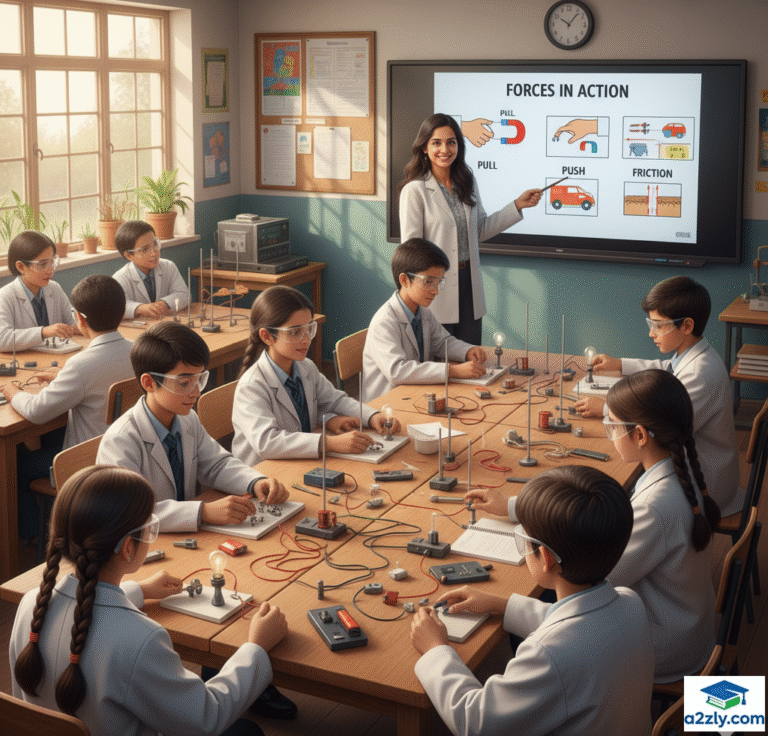🧭 Chapter Overview
Every time you throw a ball, open a door, or press a switch — you apply force.
Force is what makes objects move, stop, change shape, or direction.
This chapter, “Exploring Forces,” helps you understand how forces work, the types of forces around us, and how they are essential in both nature and technology.
By the end, you’ll see how invisible pushes and pulls shape everything — from the orbit of planets to the functioning of machines.
Table of Contents
🎯 Learning Objectives (NEP 2025 Competency Table)
| Competency | Learning Outcome | NEP Skill |
|---|---|---|
| Conceptual Understanding | Explain the meaning & types of forces | Concept Clarity |
| Analytical Thinking | Identify forces in daily life situations | Critical Reasoning |
| Application | Apply Newton’s laws to real examples | Practical Understanding |
| Inquiry | Conduct experiments with springs & magnets | Hands-on Learning |
| Ethical Awareness | Understand friction & its control | Environmental Awareness |
⚙️ 5.1 What Is Force?
Definition:
A force is a push or pull on an object that can change its state of motion or shape.
| Aspect | Example |
|---|---|
| Push | Kicking a football |
| Pull | Opening a drawer |
| Twist | Turning a bottle cap |
A force always acts when two objects interact.
SI Unit: Newton (N) — named after Sir Isaac Newton.
🌍 Effects of Force
Force can:
- Change the shape of an object (e.g., pressing a sponge).
- Change the state of motion — move or stop something.
- Change the speed or direction of motion.
Example:
- A bat hitting a ball → changes both direction and speed.
- Squeezing a rubber ball → changes shape.
⚡ 5.2 Forces in Daily Life
| Situation | Type of Force | Effect |
|---|---|---|
| Writing with a pen | Muscular | Motion |
| Falling apple | Gravitational | Pulls toward Earth |
| Car brakes | Frictional | Stops motion |
| Magnet attracting nails | Magnetic | Pulls metal |
| Balloon rubbed with hair | Electrostatic | Attracts paper bits |
🧠 Activity – Push, Pull, and Twist
Aim: Observe effects of different types of forces.
Procedure:
- Push a table → it moves forward.
- Pull a chair → it moves backward.
- Twist a bottle cap → shape changes.
Conclusion:
Push, pull, and twist are all forms of force that cause motion or deformation.
🧲 5.3 Types of Forces
1️⃣ Contact Forces – Need physical contact
| Type | Description | Example |
|---|---|---|
| Muscular Force | Force applied by muscles | Lifting, pushing |
| Frictional Force | Opposes motion between two surfaces | Brakes, walking |
| Normal Force | Supportive force by surfaces | Book resting on a table |
| Tension Force | Force through stretched string | Rope in tug of war |
2️⃣ Non-Contact Forces – Act from a distance
| Type | Description | Example |
|---|---|---|
| Gravitational Force | Earth pulls everything toward its center | Falling objects |
| Magnetic Force | Attraction/repulsion between magnets | Compass needle |
| Electrostatic Force | Attraction/repulsion due to charges | Rubbing balloon on hair |
🧱 5.4 Force and Motion
Motion = Change in position of an object with time.
Force can start, stop, or change motion.
Example:
- Pushing a stationary ball → starts moving.
- Applying brakes → stops a moving vehicle.
⚙️ “Force gives motion its life — without force, everything would remain still.”
🌬️ Balanced and Unbalanced Forces
| Type | Description | Effect |
|---|---|---|
| Balanced Force | Equal & opposite → cancel each other | No change in motion |
| Unbalanced Force | Not equal → object moves or changes speed | Motion occurs |
Example:
- Balanced: Book resting on a table (gravity down, table up).
- Unbalanced: Pushing a trolley → starts moving.
🧭 5.5 Newton’s Laws of Motion (Simplified)
| Law | Statement | Real-Life Example |
|---|---|---|
| 1st Law (Inertia) | Object remains at rest or motion unless acted upon by force | Seatbelt saves you when car stops suddenly |
| 2nd Law | Force = Mass × Acceleration (F = m × a) | Kicking a football hard moves it faster |
| 3rd Law | Every action has an equal & opposite reaction | Gun recoils when fired |
💡 Newton’s laws explain every movement — from walking to rocket launches.
🧱 5.6 Friction – A Force That Opposes Motion
Definition:
Friction is a force that opposes motion between two surfaces in contact.
| Type | Example |
|---|---|
| Static Friction | Standing still on the floor |
| Sliding Friction | Rubbing two surfaces |
| Rolling Friction | Ball bearings in wheels |
🧪 Activity – Observing Friction
Aim: Compare motion on rough & smooth surfaces.
Process:
Slide a toy car on a table and then on sandpaper.
Observation: Car moves less on rough surface → friction higher.
Conclusion:
Friction depends on surface type and weight of the object.
⚙️ Advantages of Friction
✅ Helps in walking
✅ Enables vehicles to move
✅ Allows writing, holding, and gripping
⚠️ Disadvantages of Friction
❌ Causes wear & tear
❌ Wastes energy as heat
❌ Reduces efficiency of machines
💡 Reducing Friction
- Apply lubricants (oil, grease)
- Use ball bearings
- Streamline designs (aeroplanes, ships)
🧲 5.7 Magnetic and Electrostatic Forces
Magnetic Force
Magnets attract metals like iron, nickel, and cobalt.
They have two poles — North and South.
Like poles repel, unlike poles attract.
Application:
- Magnetic compasses
- Electric motors
- Cranes for lifting scrap metals
Electrostatic Force
Generated when materials are rubbed together.
E.g., rubbing a balloon on hair attracts paper bits.
Explanation:
Rubbing transfers electrons, creating opposite charges that attract each other.
🌍 5.8 Gravitational Force – The Universal Attraction
Every object attracts every other object with a force called gravity.
Discovered by Sir Isaac Newton in the 17th century.
- Keeps planets in orbit around the Sun.
- Keeps the Moon revolving around Earth.
- Causes objects to fall downward.
Force of Gravity (F)=G×m1×m2r2\text{Force of Gravity (F)} = \frac{G \times m_1 \times m_2}{r^2}Force of Gravity (F)=r2G×m1×m2
🌎 Gravity — the invisible glue of the universe.
🧠 HOTS (Higher Order Thinking Skills)
- Why can’t we walk properly on an oily surface?
- How do astronauts feel “weightless” in space?
- Why do vehicles use rubber tyres instead of metal wheels?
- Why is friction both a friend and a foe?
- If gravity attracts everything, why doesn’t the Moon fall onto Earth?
⚙️ NEP COMPETENCY FRAMEWORK
| Domain | NEP Skill | Real-Life Application |
|---|---|---|
| Conceptual | Understand forces and effects | Push/pull demo |
| Analytical | Distinguish contact/non-contact forces | Sorting game |
| Practical | Conduct friction experiment | Toy car test |
| Creative | Build working model | Balloon car / magnet toy |
| Ethical | Apply safe handling of forces | Science fair demo |
💡 Memory Booster Box
🔹 Force = Push or Pull
🔹 Contact Forces → Muscular, Frictional
🔹 Non-Contact → Magnetic, Gravitational, Electrostatic
🔹 Balanced = No motion | Unbalanced = Motion
🔹 Newton’s Laws explain motion and inertia
🔹 Friction helps motion but causes wear
⚠️ Exam Alert Box
📍 Define: Force, Friction, Gravity
📍 Differentiate: Contact vs Non-contact forces
📍 Short Answer: Why does a ball stop rolling?
📍 Long Answer: Effects of force with examples
📍 Diagram: Magnetic field lines, forces on a table
📘 Quick Recap
✅ Force = push or pull that changes motion or shape
✅ Forces may be contact or non-contact
✅ Friction opposes motion and produces heat
✅ Magnetic and gravitational forces act from a distance
✅ Balanced forces cause no motion, unbalanced forces cause motion
✅ Newton’s laws explain the mechanics of everyday life
🔗 INTERNAL & EXTERNAL LINKS
Internal Links (A2ZLY):
- Chapter 4 – Electricity: Magnetic and Heating Effects Notes 2025
- Class 8 Science All Chapters Smart Notes 2025
- NEP 2025 Study Hub | A2ZLY
External Links:

